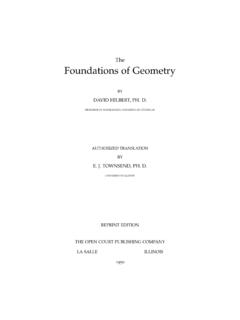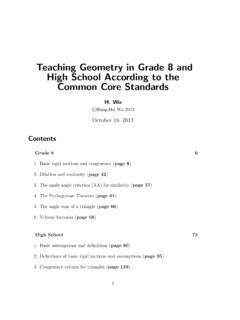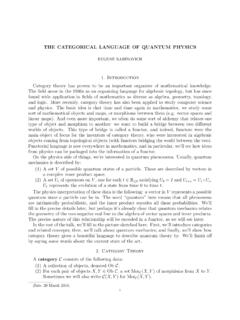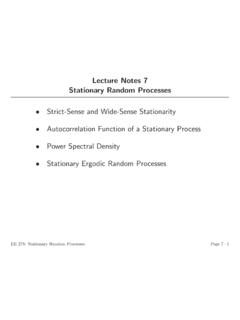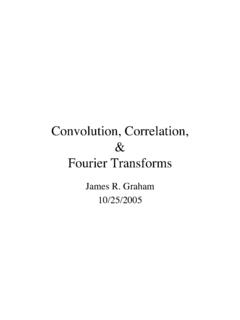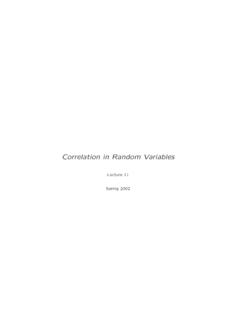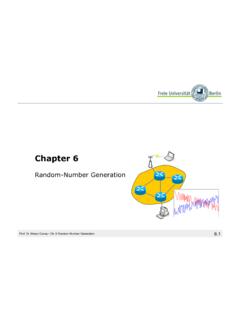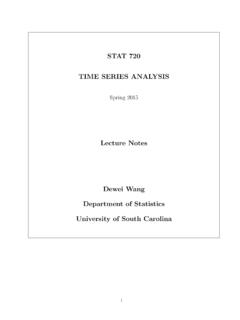Transcription of GARCH(1,1) models
1 Ruprecht-Karls-Universit at HeidelbergFakult at f ur Mathematik und InformatikBachelorarbeitzur Erlangung des akademischen GradesBachelor of Science (B. Sc.) garch (1,1) modelsvorgelegt vonBrandon Williams15. Juli 2011 Betreuung: Prof. Dr. Rainer DahlhausAbstraktIn dieser Bachelorarbeit werden garch (1,1)-Modelle zur Analyse finanzieller Zeitreihen unter-sucht. Dabei werden zuerst hinreichende und notwendige Bedingungen daf ur gegeben, dass solcheProzesse uberhaupt station ar werden k onnen. Danach werden asymptotische Ergebnisse uber rel-evante Sch atzer hergeleitet und parametrische Tests entwickelt. Die Methoden werden am Endedurch ein Datenbeispiel this thesis, garch (1,1)- models for the analysis of financial time series are investigated. First,sufficient and necessary conditions will be given for the process to have a stationary , asymptotic results for relevant estimators will be derived and used to develop parametrictests.
2 Finally, the methods will be illustrated with an empirical Introduction22 Stationarity43 A central limit theorem94 Parameter estimation185 Tests226 Variants of the garch (1,1) model267 garch (1,1) in continuous time278 Example with MATLAB349 Discussion3911 IntroductionModelling financial time series is a major application and area of research in probability theory andstatistics. One of the challenges particular to this field is the presence of heteroskedastic effects,meaning that the volatility of the considered process is generally not constant. Here the volatilityis the square root of the conditional variance of the log return process given its previous is, ifPtis the time series evaluated at timet, one defines the log returnsXt= logPt+1 logPtand the volatility t, where 2t= Var[X2t|Ft 1]andFt 1is the -algebra generated byX0,..,Xt 1. Heuristically, it makes sense that the volatilityof such processes should change over time, due to any number of economic and political factors,and this is one of the well known stylized facts of mathematical presence of heteroskedasticity is ignored in some financial models such as the Black-Scholesmodel, which is widely used to determine the fair pricing of European-style options.
3 While this leadsto an elegent closed-form formula, it makes assumptions about the distribution and stationarityof the underlying process which are unrealistic in general. Another commonly used homoskedas-tic model is the Ornstein-Uhlenbeck process, which is used in finance to model interest rates andcredit markets. This application is known as the Vasicek model and suffers from the homoskedasticassumption as (autoregressive conditional heteroskedasticity) models were introduced by Robert Englein a 1982 paper to account for this behavior. Here the conditional variance process is given an au-toregressive structure and the log returns are modelled as a white noise multiplied by the volatility:Xt=et t 2t= + 1X2t 1+..+ pX2t p,whereet(the innovations ) are with expectation 0 and variance 1 and are assumed indepen-dent from kfor allk t. The lag lengthp 0 is part of the model specification and may bedetermined using the Box-Pierce or similar tests for autocorrelation significance, where the casep= 0 corresponds to a white noise process.
4 To ensure that 2tremains positive, , i 0 Bollerslev (1986) extended the ARCH model to allow 2tto have an additional autoregres-sive structure within itself. The garch (p,q) (generalized ARCH) model is given byXt=et t 2t= + 1X2t 1+..+ pX2t p+ 1 2t 1+..+ q 2t model, in particular the simpler garch (1,1) model, has become widely used in financialtime series modelling and is implemented in most statistics and econometric software (1,1) models are favored over other stochastic volatility models by many economists due2to their relatively simple implementation: since they are given by stochastic difference equationsin discrete time, the likelihood function is easier to handle than continuous-time models , and sincefinancial data is generally gathered at discrete , there are also improvements to be made on the standard garch model. A notableproblem is the inability to react differently to positive and negative innovations, where in reality,volatility tends to increase more after a large negative shock than an equally large positive is known as the leverage effect and possible solutions to this problem are discussed further insection loss of generality, the timetwill be assumed in the following sections to take valuesin eitherN0or StationarityThe first task is to determine suitable parameter sets for the model.
5 In the introduction, weconsidered that , , 0 is necessary to ensure that the conditional variance 2tremains non-negative at all timest. It is also important to find parameters , , which ensure that 2thas finiteexpected value or higher moments. Another consideration which will be important when studyingthe asymptotic properties of garch models is whether 2tconverges to a stationary , we will see that these conditions translate to rather severe restrictions on the choiceof 1.: A processXtis called stationary (strictly stationary), if for all timest1,..,tn,h Z:FX(xt1+h,..,xtn+h) =FX(xt1,..xtn)whereFX(xt1,..,xtn) is the joint cumulative distribution function ofXt1,.., >0and , 0. Then the garch (1,1) equations have a stationary solutionif and only ifE[log( e2t+ )]<0. In this case the solution is uniquely given by 2t= (1 + j=1j i=1( e2t i+ )). the equation 2t= + ( e2t 1+ ) 2t 1, by repeated use on t 1, etc. we arrive at theequation 2t= (1 +k j=1j i=1( e2t i+ )) + (k+1 i=1( e2t i+ )) 2t k 1,which is valid for allk N.
6 In particular, 2t (1 +k j=1j i=1( e2t i+ )),since , 0. Assume that 2tis a stationary solution and thatE[log( e2t+ )] 0. We havelogE[j i=1( e2t i+ )] E[logj i=1( e2t i+ )] =j i=1E[log( e2t i+ )]and therefore, ifE[log( e2t+ )]>0, then the product ji=1( e2t i+ ) diverges by the stronglaw of large numbers. In the case thatE[log( e2t+ )] = 0, then ji=1log( e2t i+ ) is a randomwalk process so thatlim supj j i=1log( e2t i+ ) = that in both cases we havelim supj j i=1( e2t i+ ) = all terms are negative we then have 2t lim supj j i=1( e2t i+ ) = is impossible; therefore,E[log( e2t+ )]<0 is necessary for the existence of a stationarysolution. On the other hand, letE[ e2t+ ]<0. Then there exists a >1 with log +E[log( e2t+ )]<0. For this we have by the strong law of large numbers:log +1nn i=1log( e2t i+ ) log +E[log( e2t+ )]<0,solog( nn i=1( e2t i+ )) =n(log +1nn i=1log( e2t i+ )) ,and nn i=1( e2t i+ ) , the series (1 + j=1j i=1( e2t i+ ))converges To show uniqueness, assume that tand tare stationary: then| t t|= ( e2t 1+ )| 2t 1 2t 1|= ( nn i=1( e2t i+ )) n| 2t n 2t n|P means thatP(| t t|> ) = 0 >0, so t= garch (1,1) equations with >0and , 0,have a stationary solution withfinite expected value if and only if + <1, and in this case:E[ 2t] = 1.
7 Proof.: SinceE[log( e2t+ )] log(E[ e2t+ ]) = log( + )<0, the conditions of Theorem 1 arefulfilled. We haveE[ 2t] =E[ (1 + j=1j i=1( e2t i+ ))]= (1 + j=1E[j i=1( e2t i+ )])= (1 + j=1( + )j)= (1 )if this series converges, that is, if + <1, and theorem shows that strictly stationary IGARCH(1,1) processes (those where + = 1) exist. For example, ifetis normally distributed, and = 1, = 0, thenE[log( e2t+b)] =E[loge2t] = ( + log 2)<0,where is the Euler-Mascheroni constant. Therefore, the equationsXt=et t; 2t=X2t 1,or equivalentlyXt=etXt 1define a stationary process which has infinite variance at everyt. Onthe other hand, 2t= 2t 1has no stationary some applications, we may require that the garch process have finite higher-order moments;for example, when studying its tail behavior it is useful to study its excess kurtosis, which requiresthe fourth moment to exist and be finite. This leads to further restrictions on the coefficients and.
8 For a stationary garch process,E[X4t] =E[e4t]E[ 4t]=E[e4t]E[ 2(1 + j=1j i=1( e2t i+ ))2]= 2E[e4t]E[1 + 2 j=1j i=1( e2t i+ )2+ k=1 l=1k i=1l j=1( e2t i+ )( e2t j+ )]= 2E[e4t](1 + 2 j=1( + )j+ k=1 l=1E[( e2t+ )2]k l( + )k l k l),which is finite if and only if 2:=E[( e2t+ )2]<1. In this case, using the recursion 2t= + 2t 1( e2t 1+ ),E[ 4t] = 2+ 2 E[ e2t 1+ ]E[ 2t 1] +E[( e2t 1+ )2]E[ 4t 1]= 2+ 2 2 + 1 + 2E[ 4t],soE[X4t] =E[ 4t]E[e4t] = 2E[e4t]1 + + (1 2)(1 ).In the case of normally distributed innovations (et), the condition 2<1 meansE[( e2t+ )2] = 2E[e4t] + 2 E[e2t] + 2= 3 2+ 2 + 2= ( + )2+ 2 2< excess kurtosis ofXtwith normally distributed innovations is thenE[X4t]Var[Xt]2 3 =3(1 + + ) 2(1 )(1 2 2 ( + )2)( 1 )2 3= 31 ( + )21 2 2 ( + )2 3=2 21 2 2 ( + )2>0,6which means thatXtis leptokurtic, or heavy-tailed. This implies that outliers in the garch model should occur more frequently than they would with a process of normally distributedvariables, which is consistent with empirical studies of financial generally, forXtto have a finite 2n-th moment (n N) a necessary and sufficient conditionis thatE[( e2t+ )n]< interesting feature of garch processes is the extent to which innovationsetat timetpersist in the conditional variance at a later time 2t+h.
9 To consider this mathematically we willuse the following definition. For the garch (1,1)-processX= (Xt), define X(t,n) = 20t+n i=1( e2t+n i+ ) + (t+n 1 k=nk j=1( e2t+n j+ )).Definition innovationetdoesnotpersist in X inL1iffE[ X(t,n)] 0 (n ),and almost surely ( ) iff X(t,n) 0 (n ).If every innovationetpersists inX, then we see how this definition reflects the heuristic meaning of a shock innovation persisting in theconditional variance, consider that for a garch time series with finite variance,E[ X(t,n)] =E[(E[ 2t+n] E[ 2t+n|et])1 ( + )n 1n 1 i=1( e2t+n i+ )]= (E[ 2t+n] E[ 2t+n|et])1 ,which tends to zero if and only ifE[ 2t+n] E[ 2t+n|et] tends to zero as 6.(i) Ifetpersists inXinL1for anyt, thenetpersists inXinL1for allt. This isthe case if and only if + 1.(ii) Ifetpersists for anyt, thenetpersists for allt. This is the case if andonly ifE[log( e2t+ )] (i) First,E[ X(t,n)] = 20t+n i=1E[ e2t+n i+ ] + t+n 1 k=nk j=1E[ e2t+n j+ ].
10 For this value to be converge to zero (that is, foretto not persist), we needE[ 20] to be finite,which means + <1. On the other hand, let + <1. Then we haveE[ X(t,n)] = 1 ( + )t+n+ t+n 1 k=n( + )k= ( + )n1 0 (n ),7soetdoes not persist.(ii) LetE[log( e2t+ )]<0. By the strong law of large numbers,1nn i=1log( e2t i+ ) E[log( e2t+ )]<0,sologn i=1( e2t i+ ) =n(1nn i=1log( e2t i+ )) and thereforen i=1( e2t i+ ) means that we have X(t,n) = 20t+n i=1( e2t+n i+ ) 0+ (t+n 1 k=nk j=1( e2t+n j+ ) 0) the other hand, letE[log( e2t+ )] 0. Then by the argument in the proof of Theorem 1, wehavelim supj j i=1( e2t i+ ) = that X(t,n) cannot converge to is a peculiar property of garch (1,1) models that the concept of persistence depends stronglyon the type of convergence used in the definition. Persistence inL1is the more intuitive sense,since it excludes pathological volatility processes such as 2t= 3 2t 1, which is strongly stationarysinceE[log(3e2t+ 0)] = ( + log 2) + log 3< call := + the persistence of a garch (1,1) model with parameters.
